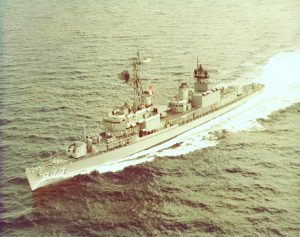The Navy was an education for me. In many ways.
The Navy was different back then. i think they continue the traditions, but those traditions, like chiefs initiations and over-the-line rituals are watered down. Political correctness, you understand. The divisions between ranks have been muddled. This may or may not be a bad thing. i am not wise enough or knowledgable enough to determine, but it is different.
And i liked the way it was.
When i was in the Navy, the lower enlisted were the work force, and boy, did they work. In fact, they were incredible workers. There are very few people in this country today who could even fathom putting in the hours at work those sailors did.
The third and second class petty officers were a transition. They too did hard labor, but their expertise and knowledge in their fields (ratings) began to give them more say in the way ships operated.
First class petty officers were escaping most of the hard labor, but they still got involved. “Leading Petty Officer” speaks of their new role in leadership.
Then there were the chiefs. Lifers. Loving the Navy. Thinking they knew as much as the old man. Some did. But as with all things, there were some really good ones and there were some who were…oh, to be nice, they weren’t quite as effective.

An Ensign learns this quickly. i did. My first ship was the USS Hawkins (DD-873). i had completed the Anti-Submarine Warfare (ASW) Officer course in Key West when i reported aboard in Malaga, Spain in April 1968. The sitting ASW officer would not leave until October. In the interim, i was the First Lieutenant, deck officer in charge of first division, boats, davits, exterior spaces, and anything else that wasn’t specifically related to any other division or department.
BMC Jones was my introduction to the way things worked. He taught me the ropes. It still amazes me how he ran first division, taught me many things about being a division officer and deck seamanship while never appearing to be in charge, always deferring to his division officer. Green upon green me. Crazy. But it worked.
Chief Jones was from the Arkansas Ozarks. He had another four months to reach twenty years. He planned to retire on the button. Chief Jones was a chain spoking, rail thin, ruddy complexion chief boatswainmate, probably around 5-8 and 130. He was not to mess with.
After we crossed the pond and completed our deployment, arriving at our homeport of Newport, Rhode Island in early May, being on a ship was different. Back then, the crew had liberty cards. They reflected which section the sailor was in. There were usually three sections rotating the duty. The duty section remained on board for 24 hours while the other two sections had liberty. Those liberty cards were handed out by the chief or leading petty officer shortly before liberty call. It had many implications not on top of the table. Liberty cards were incredible leverage for the LPO’s and CPO’s.
We had this seaman apprentice who required leverage. He was a strapping, very fit 6’2,” 180-pound young man, and pretty smart too. Problem was he wanted to use his smarts to get away with stuff until he had completed his obligation. We called sailors like this “sea lawyers.” Chiefs and LPO’s didn’t like sea lawyers. To put them in their place, the chiefs and LPO’s used leverage. Like liberty cards.
We will call this guy Seaman Farkle. Back then, you didn’t have to be so polite. Anyone below chief was called by their last name. Period. Chiefs were called chiefs. Officers were called by their rank, e.g. “Ensign Jewell.”
It was a Friday. We were cutting the hard working folks some slack. Liberty call was at noon, not the usual 1600. i had gone down to the first division berthing to check out the material condition. Farkle was there, upset. It seems he had tried some sea lawyering out on BM2 Carrier, our LPO and a very good one. Farkle was in section 2, section 3 had the duty. But when Carrier passed out liberty cards to the division, he couldn’t find Farkle’s. That meant Farkle had to remain aboard the ship, even though it wasn’t his duty day.
Farkle decided an ensign was ripe for using his sea lawyer tactics. He approached me and began an intense tirade about abuse of his rights, how he was demeaned, how the chief and LPO were acting outside of procedure, were in violation of regulations.
He was making headway on this green ensign. i wasn’t yet wise in the ways of that Navy. He had some good points, from a sea lawyer’s perspective about rights and all that, but i wanted to back Carrier and Chief Jones.
Farkle was in my face, livid with his sea lawyering when Chief Jones slid down the ladder (forward, not climbing down backwards; that’s how true sailors descended ladders). The slender, wiry chief slid in front of me and grabbed Farkle’s shirt at the top two buttons. Then he pushed Farkle against the bulkhead and with one hand lifting the young man about six inches off the ground. Then Chief Jones read Farkle the riot act like only Boatswainmate chiefs can do. It was classic and can not be repeated here because non-that-era tincan sailors are the only people who would understand, and others will read this.
All sea lawyering disappeared from Farkle. He was a quivering mass of fear, nodding affirmatively and declaring his fealty.
Farkle stayed on board that weekend.
i learned a valuable lesson about the old Navy…and i loved it.
